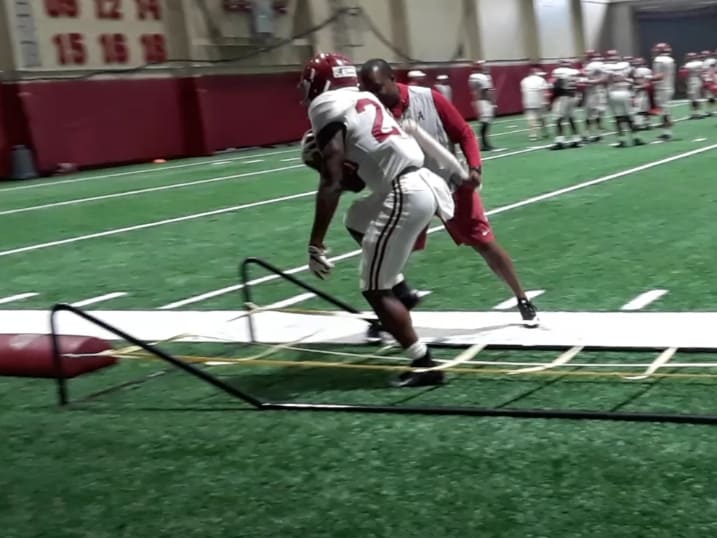Running backs contribute to offense in multiple ways
August 9, 2019
Alabama might have the best quarterback in college football.
It might have the best group of wide receivers, too.
But on Saturdays this fall when the timing of the passing game is just a little bit off, Tua Tagovailoa takes one too many hits or the Crimson Tide needs to salt away a victory, the running game will take center stage.
Junior Najee Harris, the No. 1 running back recruit in the class of 2017, finally gets his chance to be the lead running back after two years as part of the rotation. Offensive coordinator Steve Sarkisian seemed to confirm Harris’ role at his Saturday morning press conference.
“Ideally we want Najee to be fresh and continue to get better as the season goes on, and later in the year,” Sarkisian said. “ … There may be games in which he is that total bell-cow and we have to go the way we need to go to do what we need to do to win the game. There may be other games in which it’s not as many. Maybe we do find ways to get him the ball in the passing game and different things.”
Harris is the only running back on the team who has caught a pass in a live game, having caught 10 over his two seasons in Tuscaloosa.
Last year running backs accounted for 46 of the team’s 301 completions (15.3%), most of which were by Damien Harris and Josh Jacobs, who are both now in the NFL. In 2017 the running backs were even more involved, catching around the same number of passes on nearly 100 fewer attempts (49 for 204, or 24.0%).
“The running backs and receivers out of the backfield are a big benefit for us, especially when we know there’s going to be so much attention on the four wide receivers,” Sarkisian said. “I think we can create some good matchups with our running backs.”
Alabama also demands that its running backs be adept at pass protection, meaning they’re sometimes responsible for handling unblocked pass rushers.
Robinson said his coaches at Hillcrest High School in Tuscaloosa made sure to develop his entire skill set so he could contribute earlier in his collegiate career.
“[Hillcrest coach Sam Adams] knew that I was going to have the opportunity to play at the next level,” Robinson said. “So he tried to do everything he could to possibly develop me so I could come in and be prepared. So I adjusted pretty well to the passing game and pass protection.”
Inexperience with pass protection can keep a supremely talented runner on the sideline. The San Francisco Chronicle reported last summer that coach Nick Saban told Harris after his freshman year that he needed to refine his pass protection to earn more playing time.
That may have been partly the case for Robinson last year, but he was also buried behind Jacobs and Damien Harris, two early-round draft picks, and Najee Harris, who appears on track to join them next spring.
Robinson, the eighth-ranked running back in the 2017 class, saw his carries increase from 24 as a freshman to 63 as a junior. Of those 63, though, 52 occurred in the fourth quarter and only two came before halftime. Both were 1-yard gains with Alabama leading Louisiana-Lafayette 42-0.
The Crimson Tide’s average lead when Robinson carried the ball was 40.6 points, and he had zero carries with the team leading by fewer than 26 points.
“Just coming from high school, being that guy, you expect to go out there and just be granted the opportunity immediately. You’re like, ‘Why am I not this? Why am I not this?’” Robinson said. “ … If you’re not ready to play, the coaches are not going to lie to you. The film’s not going to lie to you.”
Despite Robinson’s limited touches, Harris could attest to his value. Robinson frequently entered games as a fullback in goal-line situations last year and blocked for Harris on two of the latter’s four rushing touchdowns.
“I don’t think (limited playing time) impeded his development at all because he’s got great knowledge and experience and he’s been able to play enough to know what it’s like to play in big games,” Saban said. “I’m sure he’ll do a great job for us this year.”
Saban said during the spring that Harris, Robinson and sophomore Jerome Ford were all progressing nicely, but he hoped the team’s incoming freshmen would complement the veterans like former All-Americans Mark Ingram and Trent Richardson did as freshmen. That’s where Trey Sanders comes in.
The nation’s top freshman running back attended football player factory IMG Academy in Florida, flashing breakneck speed and break-ankle quickness. Like Robinson’s coaches at Hillcrest, though, he’s not just a runner.
“That’s why he came here: to be great when the ball wasn’t in his hands,” IMG coach Kevin Wright said. “You talk about being an instinctive runner. Trey obviously is. But to be great when the ball’s not in your hands and to be able to share carries, be unselfish, all those things… I think he’s ready. He’s been prepared for conceptually how that works.”
Saban, despite saying Sanders has done “really, really well” so far, was non-committal about the true freshman’s role in the offense – or anyone else’s, for that matter. The coach’s advice to his running back room is the same as Robinson’s: If you’re not pleased with your role, keep grinding and earn it.
“So, most guys, it’s just hard for them to just accept the fact that they’re just not ready to play as much as they think that they’re ready to play,” Robinson said. “You should take that as a humbling experience and just focus on just getting better so that you are ready to play.”








